In this article, you learn what a is Jet Engine, and the types of Jet Engines explained with their construction, and working principles.
You can also download the PDF of this article at the end of it.
What is a Jet Engine?
A jet engine is a form of internal combustion engine in which hot gases are produced by the combustion of fuel. The hot gases produced by the combustion of fuel are compressed air.
It works on Newton’s third law; the moving body is propelled in the opposite direction to the jet. It is mostly applied on the jet engine but is also the most common means of spacecraft propulsion. This jet is used for propelling the vehicle in which the system is mounted, such systems are known as the jet propulsion system.
The hot gases produced are discharged through a nozzle in the form of a jet with a very high velocity. This produces a required thrust in the opposite direction known as a propulsive force, which is responsible for moving the vehicle.
The jet propulsive engine may be divided into two distinct types,
- That which uses atmospheric air as its oxidant (turbo engine).
- That which carries oxygen for its requirement (rocket motor).
Read also: What V8 Engine (Eight-Cylinder Engine) and How It Works?
Types of Jet Engines
Following are the main types of jet engines, which are described below:
- Turboshaft engine
- Turboprop engine
- Turbofan engine
- Turbo Jet Engine
- Ram Jet Engine
- Rocket Motor
#1 Turboshaft Engine
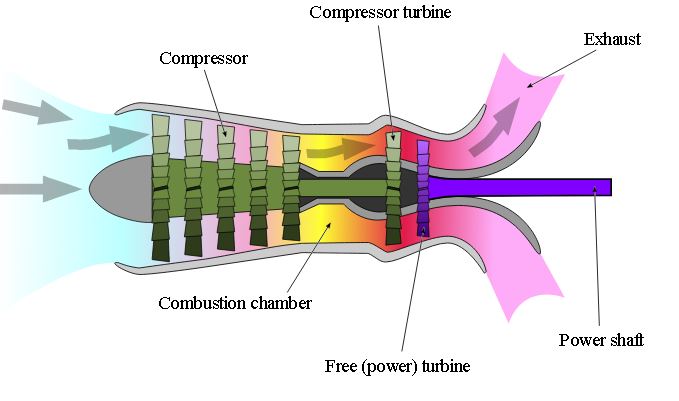
A turboshaft engine is a type of gas-powered turbine that works similarly to a turboprop engine. Turboshaft engines do not drive propellers. It is used in helicopters to power the rotor.
The difference between turboshaft and turbojet is that turboshaft engines use most of their power to turn the turbine, not to generate thrust from the rear of the engine. These are turbojet engines with a large shaft attached to the rear.
Turboshaft engines are designed such that the speed of the helicopter rotor rotates independently of the speed of the gas generator. This helps in keeping the speed of the helicopter rotor constant if the gas generator speed is reduced.
It also controls the power that a helicopter produces. Turboshaft engines obtain their propulsion by converting high-speed gases into mechanical power to drive auxiliary equipment such as turbines and compressors.
#2 Turboprop Engine
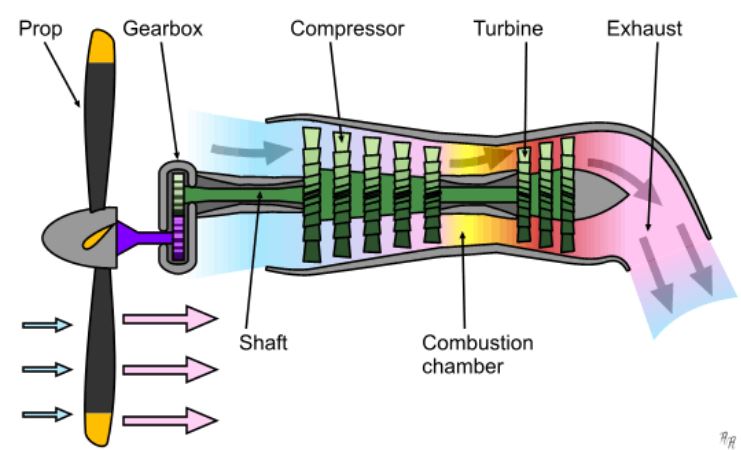
The first turboprop engine was built in Budapest in 1938. It is a type of jet engine that uses a gearing system to connect to an aircraft propeller. Turboprop aircraft engines save fuel and spin at medium-range speeds.
Turboprop engines are good at mid-range altitudes, but their weight is likely to damage the gearing system. A turboprop engine consists of a combustion chamber, containing pressurized air and gas, a turbine, and a compressor.
Although, modern turboprop engines have smaller propeller diameters. These engines have multiple blades that help stabilize the aircraft at altitude. Like a turbofan aircraft engine, a turboprop engine converts gas stream energy into mechanical power to achieve its propulsion.
This propeller generates power to drive the load, accessories, and compressor. Such jet engines come with shafts attached to the turbines that drive the propellers through a reduction gear system.
3. Turbofan Engine
These engines have a large fan at the front to suck in the air. Towards turbofan jet engines, most of the air flows around the aircraft engine allowing the aircraft to fly more loudly or quietly, even at low speeds.
The turbofan aircraft engine is an improved version of the turboprop and turbojet engine. It works like a turbojet engine but with a ducted fan mounted at the front. This has the advantage that the engine cools down, producing additional thrust and reducing aircraft engine noise.
Working of Turbofan jet Engine
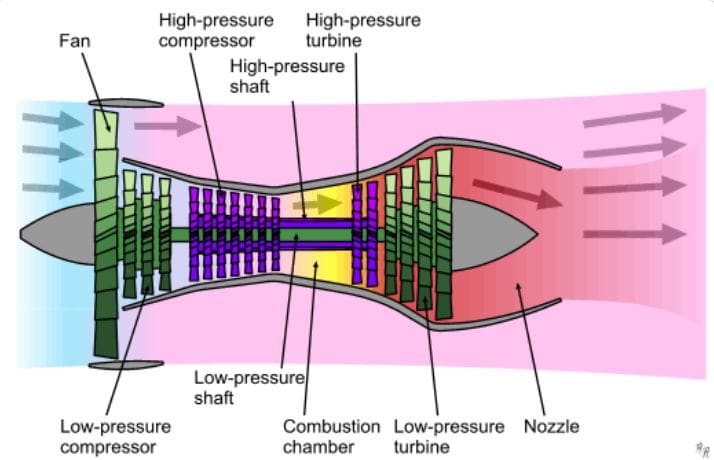
Air enters the intake of a turbofan jet engine, and flows through a generator, which contains a turbine, combustion chamber, and compressor. From this, only a little of the air passing through the turbofan engine reaches the combustion chamber.
That remaining air passes through compressors or fans when it is mixed with the gas produced or discharged. This system is meant to help achieve higher thrust while maintaining the same level of consumption.
The turbofan lowers the velocity within the same level as the jet engine’s power supply and increases it to achieve this total air mass flow.
4. Turbo Jet Engine
These types of jet engines take their oxygen supply from the surrounding atmosphere. The turbojet engine contains a diffuser at the front end and an expansion nozzle (also called a propelling nozzle) at the rear end. The energy produced consists of a combustion chamber, a fuel pump, a gas turbine, and an air compressor.
The air is compressed into the chamber, it is heated, and expanded by the fuel combustion. It is then allowed to expand through a turbine into a nozzle, where it is accelerated to high speed to provide propulsion.
Working of Turbo Jet Engine
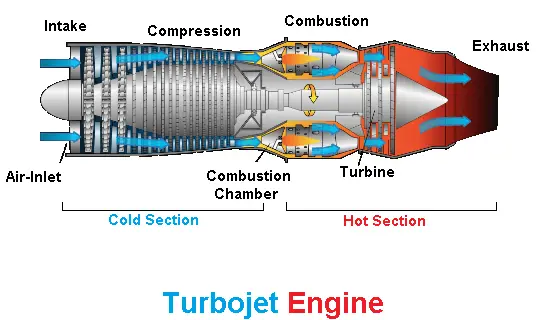
Atmospheric air enters the diffuser with the same velocity as the propulsion unit. The function of a diffuser is to convert the kinetic energy of entering air into its pressure energy. The high-pressure air now enters the compressor, where its pressure is increased and the temperature rises accordingly.
The high-pressure and temperature compressed air now enters the spherical combustion chamber in which the liquid fuel is injected through a ring through a pump. In the combustion chamber, the fuel burns at constant pressure by coming in contact with hot compressed air.
The hot gases thus generated in the combustion chamber now enter a gas turbine in which it expands to produce power. It is with this power that the compressor and the fuel pump are operated. Now, the exhaust gases from the turbine pass into the atmosphere through the expansion nozzle.
As the exhaust gases pass through the nozzle, their pressure energy is converted into kinetic energy. The gases leave the nozzle with a very high velocity creating a reactive force or thrust in the opposite direction. This moves the propellant unit forward.
5. Ram Jet Engine
In these types of jet engines, the ramjet is the simplest of all the propulsive units. Ramjet requires neither a compressor nor a turbine. The ramjet is the simplest type of jet engine because it has no moving parts.
It consists of three main components such as a diffuser, combustion chamber, and expansion nozzle. The pressure of the incoming air improves to a high value by the diffuser.
This type of engine requires a hollow tube into which fuel is injected, mixed with air, and burned to generate thrust, as shown below. The ramjet only works if it is already moving fast enough to compress the incoming air by simply forcing it into the engine.
Working of Ram Jet Engine
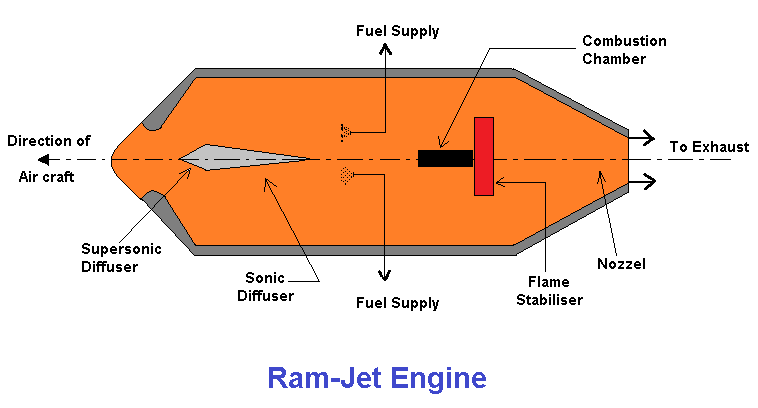
At the start, the ramjet is moved and accelerated to about 500km/h by some booster device with maybe a small turbo-jet unit. After high speed is attained in the ramjet, air enters the diffuser at the speed of the ramjet.
The use of a diffuser is to convert the kinetic energy of entering air into its pressure energy. Fuel is now injected through a fuel injection nozzle and ignited through a spark plug. Hot gases are generated, now diffuse into the expansion chamber, and eventually leave the expansion unit through the expansion nozzle.
As the exhaust gases pass through the nozzle, their pressure energy is converted into kinetic energy. Then, the gases leave the nozzle at very high velocity producing a reactive force or trust in the opposite direction.
The ramjet engine works efficiently only when its speed is supersonic. For this reason, this engine is not used in aircraft; It is used in missiles.
6. Rocket Motor
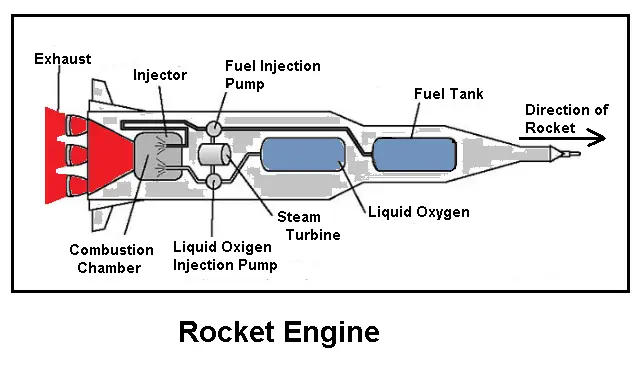
A rocket motor is a type of jet engine that generates its supply of oxygen. It is used in outer space, where there is no trace of air. It consists of a cylinder in which a fuel tank, oxidizer tank, combustion chamber turbine, and expansion nozzle are incorporated.
A rocket motor is a reaction engine. Its principle is that the fuel contained within the rocket’s body is rapidly expanded and ejected from the rocket’s tail cone nozzle. This reaction then causes thrust and drives the rocket forward.
Rocket thrust is the reaction force provided by deported particles at high velocity from a nozzle hole. These deported particles may be solid, liquid, or gaseous. The engine’s ability to generate thrust will be affected as long as the supply of particles or working fluid remains out.
Advantages and Disadvantages of Jet Engines Over Reciprocating Engines:
Advantages
The following are the advantages of using a jet engine:
- The weight of a jet engine is less than a quarter that of a reciprocating engine.
- A jet engine is free from unbalanced forces because there are no reciprocating parts.
- The frontal area of a jet engine is less than a quarter of the frontal area of reciprocating engines, which greatly reduces drag. Therefore, it provides more power at higher loads.
- The speed of a jet engine is not limited by the propeller, which means that higher speeds can be achieved.
- A jet engine can be built with a much higher power output than reciprocating engines because power is not limited by detonation. Higher power can be achieved.
Disadvantages
The following are the disadvantages of using a jet engine:
- Especially at low pressure, the thermal efficiency is low. Fuel consumption is more than a reciprocating engine at low altitudes and speeds up to 150 m/s/540 kmph.
- The working place is too noisy, the materials are expensive, and life is short.
- The compression-pressure ratio is similar to the reciprocal but changes with speed.
- Some difficulties arise in the operation of the propellant unit.
Conclusion
That’s it, Thanks for reading. So now, I hope that I have clear all your doubts about the working of a jet engine and all types of jet engines. If you have any questions about “types of jet engines” please tell us in the comments.
Now I understand that you must have liked the article written by me. If your answer is yes then please share this with your friends.
Download the PDF file of this article:
Subscribe to our newsletter to get notified when we upload new articles.
You might like reading these: